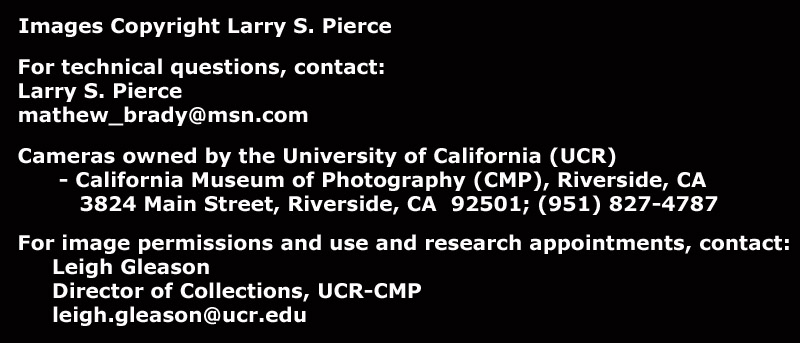Wood Finishes in Field Cameras
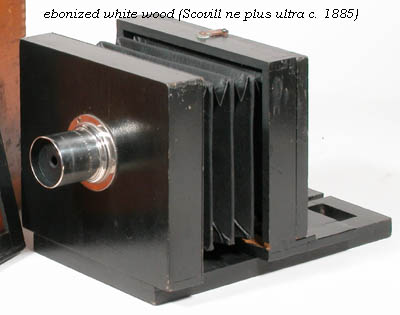 The
very cheapest finish to be applied to early (1880's) field cameras is
black paint. It was used to cover up inexpensive wood, as was a
serviceable, if not elegant, finish. For marketing, this finish
was called ebonized, to make it sound mysterious and perhaps
oriental, after the popular black lacquered decorative objects being
imported from Japan at the time.
The
very cheapest finish to be applied to early (1880's) field cameras is
black paint. It was used to cover up inexpensive wood, as was a
serviceable, if not elegant, finish. For marketing, this finish
was called ebonized, to make it sound mysterious and perhaps
oriental, after the popular black lacquered decorative objects being
imported from Japan at the time.
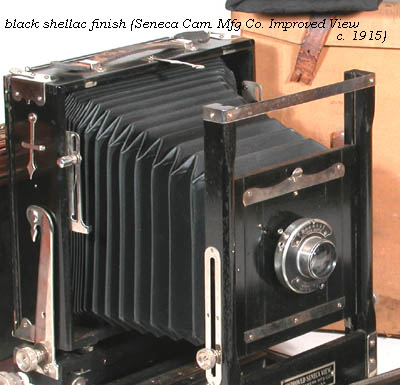 Much
later (c. 1910), Seneca used black shellac as an option in their
Seneca View, Improved, which was not a cheap finish, but every
bit as well applied as their clear shellac.
Much
later (c. 1910), Seneca used black shellac as an option in their
Seneca View, Improved, which was not a cheap finish, but every
bit as well applied as their clear shellac.
The two clear finishes primarily used on view cameras were varnish and shellac. As used during the period 1870-1930, of interest here, varnish was used on medium-quality cameras, since its mode of application, brushing, was less time intensive than the principle mode of shellac application, French polish. For some models, the finish is the main difference, such as two models produced by E.&H.T. Anthony: the Champion was varnished, and the N.P.A. was French polished, but otherwise, they were essentially the same camera (the hardware was finished better on the N.P.A., too).
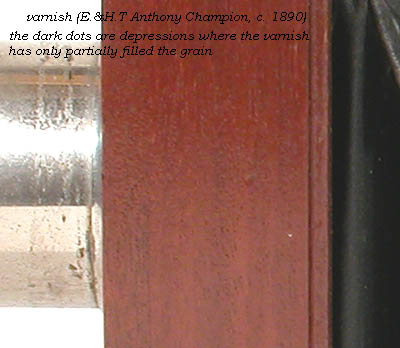 Varnish
in the 1800's was a product made by mixing and cooking various drying
oils, such as Linseed oil, and resins, such as amber, copal or rosin,
together, then thinning in turpentine to a brushable consistency.
Since the open-grained mahogany usually wasn't filled, and only one
application of varnish was used, the finish is rather thick, rounding
the contours of the wood, yet depressions from the grain are still
visible.
Varnish
in the 1800's was a product made by mixing and cooking various drying
oils, such as Linseed oil, and resins, such as amber, copal or rosin,
together, then thinning in turpentine to a brushable consistency.
Since the open-grained mahogany usually wasn't filled, and only one
application of varnish was used, the finish is rather thick, rounding
the contours of the wood, yet depressions from the grain are still
visible.
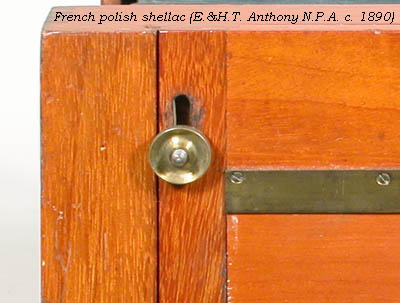 Shellac
is an alcohol extraction of the secretions of the lac insect. As
the alcohol evaporates, a polymer-like coating is left behind. The
shellac commonly available already solvated in hardware stores today is
more refined and lighter in color that that used in the 1800's.
Products like seed-lac and button-lac are available from specialty wood
stores, and are essentially what was used then, but they are dried and
must be dissolved to be used. Shellac can be brushed, but, by far,
most shellacked cameras were finished by the process of French polish.
Briefly, French polish involves multiple (hundreds) of strokes of a
shellac-charged cloth over the wood. Because the shellac already
on the wood is still soluble, each stroke adds more shellac into
crevices, while removing excess from the surface. The result is a
surface which is mirror-like in smoothness, yet relatively thin.
The shellac finish on even 100 year-old cameras is still soluble in
alcohol, so one must be careful.
Shellac
is an alcohol extraction of the secretions of the lac insect. As
the alcohol evaporates, a polymer-like coating is left behind. The
shellac commonly available already solvated in hardware stores today is
more refined and lighter in color that that used in the 1800's.
Products like seed-lac and button-lac are available from specialty wood
stores, and are essentially what was used then, but they are dried and
must be dissolved to be used. Shellac can be brushed, but, by far,
most shellacked cameras were finished by the process of French polish.
Briefly, French polish involves multiple (hundreds) of strokes of a
shellac-charged cloth over the wood. Because the shellac already
on the wood is still soluble, each stroke adds more shellac into
crevices, while removing excess from the surface. The result is a
surface which is mirror-like in smoothness, yet relatively thin.
The shellac finish on even 100 year-old cameras is still soluble in
alcohol, so one must be careful.
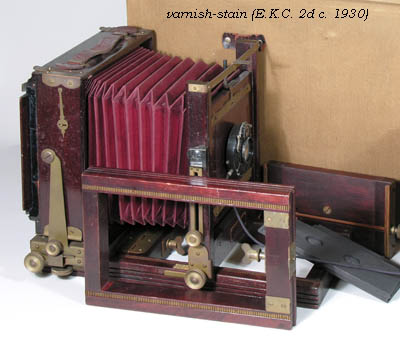 Until
the 1920's, the fashion in cameras was generally clear finishes with no
staining or altering of wood color. In 1921, the Kodak 2d was
introduced. The d designated a dark, purple-walnut-colored
finish (also popular on Sheraton revival furniture of the era), which
was also used on some commercial and studio models. Ansco followed
with dark finishes on its view cameras of the 20's.
Until
the 1920's, the fashion in cameras was generally clear finishes with no
staining or altering of wood color. In 1921, the Kodak 2d was
introduced. The d designated a dark, purple-walnut-colored
finish (also popular on Sheraton revival furniture of the era), which
was also used on some commercial and studio models. Ansco followed
with dark finishes on its view cameras of the 20's.
